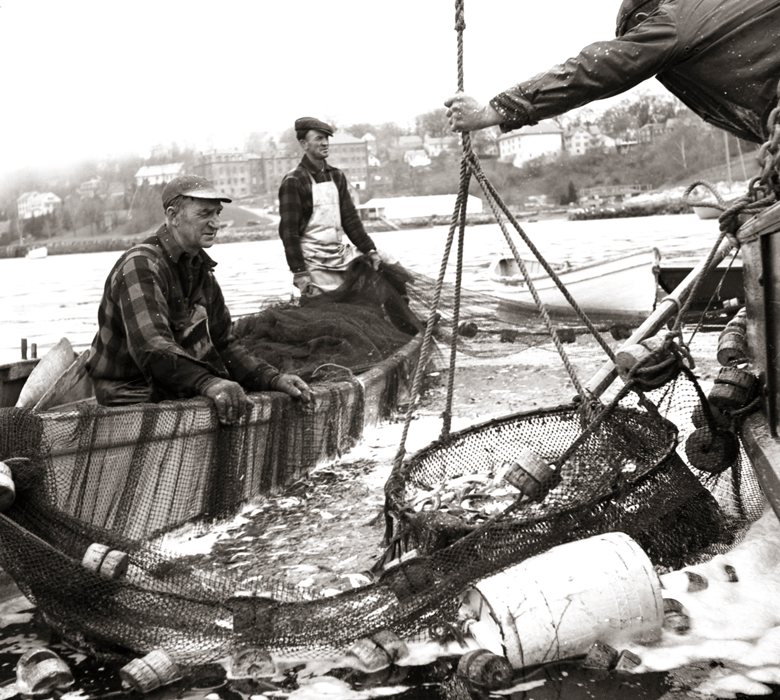In this month’s image, Harlan Hurd sits in his dory wearing a ball cap and a heavy flannel jacket which is covered in fish scales. His son, Karl, stands at the other end of the dory wearing a jeff cap and an apron over his own flannel coat. They watch as a bailing net filled with Atlantic herring is raised out of their purse seine in the Wadsworth weir in Rockport Harbor, circa 1949.
Native Americans called herring the “fish that feeds all.” Hurd was one of the last local fishermen to use weirs rather than more mechanized forms of fishing like the trawl nets that decimated the herring population. It was not long after this photo was taken that herring carriers started to use pumps which could suction herring out of a weir or seine and dump the catch into the hold of the carrier, saving hours of work.
Harlan Hurd died on Christmas Day in 1981 at the age of 90. His son Karl died in 2021 at the age of 94. They are both buried in Ash Point Cemetery near Owls Head.
The photo was taken by Rockport artist and photographer Carroll Thayer Berry. Using a medium format camera, he carefully composed the scene, using the square shape to neatly frame all the components. While Berry is more known for his wood block prints, he was also an avid photographer and member of the Knox County Camera Club.
Without a doubt, Rockport Harbor was one of his favorite places to photograph, and he made thousands of photographs there. Berry was a founding member of Maine Coast Artists, now the Center for Maine Contemporary Art, and worked with photographers Kosti Ruohomaa and Jim Moore to publish Maine Coastal Portrait in 1959.
He donated his photographs and negatives to the Penobscot Marine Museum in 1977. He died at the age of 90 in Rockport in 1978.
The Penobscot Marine Museum on Route 1 in Searsport has 500,000-plus historic images in its photography archive. Composed of scores of individual collections, it’s the largest in Maine. The content ranges from late-19th century cyanotypes of the Boxer Rebellion in China to the launching of new lobster boats in tiny harbors on the Maine coast. It encompasses one of the most intriguing glass plate negative collections we know of: an early 20th century real-photo postcard manufacturer who had an extraordinary vision for his business.
The archive documents the decades of progress in fishing technology that depleted the fish stocks of New England, and photos that Berry used as studies for his woodcuts. The photos make connections: logging camps to lumber schooners on the coast; Maine shipyards to views of a crowded Hong Kong harbor; farming to the ice shipping industry that required hay for insulation; and fishing nets teeming with herring to the 2010 closing of the last sardine cannery in the U.S. The power of the images is enormous. They teach, inspire, infuriate, and amuse.
The Penobscot Marine Museum is open daily through Oct. 16. The foyer of the Stephen Phillips Memorial Library at the museum offers an overview of the major photography collections and photographers with biographies, examples of work, and related ephemera. A large digital display features a rotating slideshow showing highlights from the archive. On weekdays, visitors are welcomed into the photo archives where there are additional displays, and they can observe and interact with staff and volunteers.





